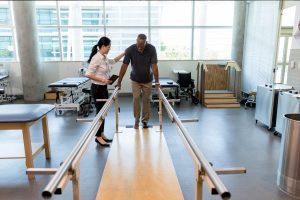Dr. Mauk’s Boomer Blog
Each week, Dr. Kristen Mauk shares thoughts relevant to Baby Boomers that are aimed to educate and amuse.
Dr. Kristen L. Mauk, PhD, DNP, RN, CRRN, GCNS-BC, GNP-BC, FAAN

Guest Blog: The Importance of Early Rehabilitation for Injury Recovery
If you’ve ever been injured, you know how hard it can be to get back to your normal routine. You want to make sure that your injury heals properly, but you also need to stay active in order to rebuild strength and mobility. That’s why it’s so important to start early rehabilitation as soon as possible after an injury occurs—even if it means taking a few days off from work or training until the initial pain subsides.
Early Rehabilitation is the key to a successful recovery from injury
Early Rehabilitation is the key to a successful recovery from injury.
Early intervention is essential to ensure an optimal outcome following trauma or surgery, and can help you return to your previous level of function with minimal risk of developing chronic pain. Early rehabilitation helps reduce your risk of developing chronic pain and restores normal movement patterns, joint integrity and strength. Afterwards proteins must be consumed in your diet as it helps in many ways to cure injury.
Recovery from an injury doesn’t have to be stressful or frustrating.
Recovery from an injury doesn’t have to be stressful or frustrating. In fact, rehab can be a fun and rewarding experience if you’re willing to listen to your body and work with it as much as possible.
In the weeks following surgery or an acute injury, there are several things you can do to prepare yourself for the road ahead. It’s important that you don’t rush into activity–if anything hurts even slightly, take a break! Listen closely when doing any kind of physical activity; if there is any pain or discomfort at all (even slight), stop immediately and rest until the next day before trying again.
This may seem counterintuitive at first but allowing yourself plenty of time between sessions will allow tissues in need of healing time for proper recovery and repair without causing further damage by rushing through exercises too quickly or ignoring warning signs from your body telling you something isn’t quite right yet. For injuries with major marks scar treatment should be provided.
The longer you wait before starting your rehabilitation, the harder it will be to recover.
The longer you wait before starting your rehabilitation, the harder it will be to recover. The longer you wait, the more your body will change. Your muscles will atrophy and become weaker over time if they’re not being used regularly; if you have an injury that prevents physical activity (as many do), this can cause serious problems down the road.
The longer we delay getting back into our daily routines after an injury or surgery, the harder it gets for us to regain strength and range of motion in our joints as well as regain confidence in using them again–which means that even after rehabilitating ourselves properly once we start, we may still find ourselves struggling with mobility issues later on down the line!
Early intervention is key to a speedy recovery.
The earlier you begin rehabilitation, the better. In fact, research has shown that early intervention can help you return to your previous level of function and reduce your risk of developing chronic pain. Early intervention also helps restore normal movement patterns and joint integrity by focusing on gentle exercise that encourages movement without causing pain or further injury.
Early rehab is also a good way to prevent injuries in the first place: if you’re not working out after an injury or surgery, it’s easy for other parts of your body (like muscles) to weaken while they’re resting–and this can make them more susceptible to getting hurt again later on down the road.
Early rehabilitation can help you return to your previous level of function.
You may think that rehabilitation is a quick and easy fix. Unfortunately, it’s not.
Rehabilitation is a process that takes time and involves many steps. The goal is not to make you feel better or stronger in the short term; rather, it’s about helping you return to your previous level of function and independence as soon as possible so that you can resume normal activities without pain or limitations on your ability to do things like walk up stairs or pick up objects from the ground.
The best way for this process to work effectively? Start early!
Early rehab helps reduce your risk of developing chronic pain.
Early rehabilitation can help you recover from an injury faster and reduce the risk of developing chronic pain.
Early rehabilitation is important because it helps prevent chronic pain, which is often a result of inactivity and immobility after an injury. When you’re injured and can’t move, your muscles start to weaken over time. Without regular exercise or movement, these weakened muscles become even weaker–and more likely to cause injuries down the road as they try to carry out tasks that are too much for them! This process is known as muscle atrophy (loss of size) or weakness due to disuse atrophy (loss). In other words: if you don’t use it now…you might not be able to use it later on!
Another reason why early rehab matters so much? It may help keep surgery at bay! Studies have shown that people who participate in physical therapy following their injury have fewer surgeries than those who do not receive therapy services.* In addition, those who receive early intervention tend not only experience less pain but also return back into work sooner than those who do not receive any kind of treatment whatsoever.*
Early rehab helps you restore normal movement patterns and joint integrity.
The first step in the rehabilitation process is to restore normal movement patterns and joint integrity. When an injury occurs, there are often changes in the way you move, including muscle weakness and loss of mobility. Your physical therapist will help you regain these abilities by guiding you through a variety of exercises that focus on specific muscles and joints.
The goal of early rehab is to get you back to your previous level of activity as soon as possible while reducing the risk of further injury or pain caused by continued use without proper treatment (known as overuse).
It’s important to work with a doctor and physical therapist who understand the needs of athletes, and can help you stay on track with your recovery.
It’s important to work with a doctor and physical therapist who understand the needs of athletes, and can help you stay on track with your recovery. You also need to stay motivated and positive.
If your injury is severe enough to require surgery, there are some things that can be done in the early stages of rehabilitation before surgery:
- Prehabilitation exercises – these are exercises that help prepare muscles for activity after surgery or an injury (e.g., stretching)
- Postoperative care instructions from doctors or physical therapists
Conclusion
We hope this article has helped you understand the importance of early rehabilitation, and how it can help you recover from injury. The longer you wait before starting your recovery plan, the harder it will be to get back to normal. It’s important to work with a doctor and physical therapist who understand the needs of athletes, so they can keep track of your progress throughout treatment.
3 Hidden Signs of Mobility Problems
While you don’t have to be overly observant to recognize that difficulty walking can spell trouble for your mobility, you may not necessarily be on the lookout for less subtle signs that can serve as red flags too. Check out this quick list of three hidden signs of mobility problems:
Avoiding Stairs
Are you opting to take the elevator more than normal? How about spending more time on the ground floor of your home to avoid using a staircase? Stairs can be one of the most difficult environments to traverse when mobility problems are starting to set in.
Stairs require extra leg strength, coordination, and balance. Avoiding stairs, whether conscious of it or not, could be a red flag. Same goes for exercise. If you are finding excuses to skip regular exercise because of mounting difficulties with getting around, it’s time to seek assistance.
Frequent Falling
While falls aren’t all that uncommon for seniors (one out of four seniors experiences a fall every year), frequent falling could indicate mobility difficulties. Even if you have not yet experienced an injury due to a fall, the fact that you fall even more than once a year could shed light on underlying risk factors negatively impacting your mobility including motor impairment and balance problems.
Chronic Illness
You may think that only chronic illnesses which directly affect your leg strength and coordination would impair your mobility, like Parkinson’s or multiple sclerosis, however, you would be wrong. Conditions including diabetes, arthritis, and even heart disease can play a role in reducing your ability to quickly and safely move with ease.
Heart failure, for example, can leave your short of breath when you walk or stand for long periods of time. Diabetes can affect nerves in the legs and feet and arthritic joint inflammation can make walking painful.
Researchers have found less common risk factors that also increase an older adult’s chances of developing mobility problems. These include drinking or smoking, recent hospitalization, having symptoms of depression and experiencing memory and critical thinking problems.
Mobility difficulties do not need to be the end of the line for you. Advancements in technology, design, and engineering have revolutionized the assistive devices people with mobility problems can use. Utilizing equipment to help keep you mobile like motorized scooters, walkers, canes, and specialty wheelchairs can play an important role in both your health as well as your outlook on life.
Guest Blog: Adult day programs giving a new life to the adults
Those who had enjoyed a considerable amount of independence in their youth, the time has come when they need help from others as they were migrated to old age. Life is never static, and it keeps on changing from time to time because change is the integral and inherent part of life. Once you cross the fancy days of your youth and step into adulthood, life becomes more challenging than ever. It took a big leap when you get older and started calling by the people as elderly.
The adult day care homes came up as a hope for many adults who are living a lonely and concise life. They have given them many reasons to enjoy their adulthood, keeping aside all their worries and tensions of life. Many daycare homes in the USA have gone to the extent of providing a friendly and composite environment that even doesn’t get in their homes. The adult day programs in Atlanta offer a welcoming environment to the adults by connecting them back to mainstream society and expanding their outreach. They provide support and a needed break for someone who cares for a loved one who is no longer independent.
Every adult is welcomed in an adult day care home.
The adult day care homes take care of every adult regardless of their religion, race, and ethnicity. Caregivers in the Atlanta adult day care homes are not the ordinary people infect they are the one who is not doing this just as a job but it’s is their passion and nature to help elders and share their pain and joy. All the adults staying in the adult day care homes spent their day with loads of fun and doing meaningful activities.
It is not that adult daycare homes only provide emotional or medical support to the adults; they also facilitate adults by organizing musical events and taking them to cultural festivals. Some of them hold weekly performances by local musicians and local entertainers. They also give them the opportunity for interactions with pets and children, cooking projects, take them to nature walks, games, parties, and yoga classes.
Who joins adult day care homes?
- Adults in their 50s – 90s with some physical or cognitive behavioral problems.
- Older adults who don’t wish to stay home alone all through the day.
- Older adults can benefit from social interaction and a structured environment.
- Adults who are abandoned by their family and they are forced to live alone.
- Adults whose children are not living with them because either for work or study, they have to live outside the town or country.
Loads of Surprises
It is not that the adults living in the Adult Daycare homes are entirely cut off from their families and friends. This is not the case with every adult day care home because many Adult daycare homes provide surprise adults’ by suddenly calling their family members and close friends for a quick meet up or gathering.
As much as adults miss their family members, their family members also miss them equivalently.
Learn and earn schemes
Money adult Daycare homes also provide learning and earn schemes to the adults who want to do something big in their life. It doesn’t mean that if you are elder or older, your professional life is over. Many adults are still willing to work after their retirement from their professional life. The adult Daycare homes provide equal opportunities for adults.
6 Ways to Keep Seniors Safe During the Holiday Season

The holidays are just around the corner. While it can be the best of times for many, it can also be the worst of times for some. On the one hand Holiday Season means turkey, gifts and family. On the other hand, it can also mean cold, ice, darkness and loneliness.
Here are a few tips on how you can help your mom, dad or yourself stay safe during the holiday season.
1. Get the flu shot
Up to 85% of flu related deaths happen to those over the age of 65. The Center for Disease Control suggests get the flu vaccine is the best way for seniors to avoid getting the flu. It’s often free under Medicare, Medicaid, insurance plans under the Affordable Care Act and many private employer and school insurances.
2. Avoid isolation
Winter conditions have a tendency of keeping folks indoors, especially less mobile seniors, making isolation a real risk.
Check up on your parents frequently. Make sure they’re not missing any medical appointments, they’re getting their medications, their fridge is full and they’re connected to their support system. Arrange transportation if necessary.
3. Walk safely outdoors
Icy conditions and uneven walking surfaces dramatically increase the risk of outdoor falls. Consider crampons for extra grip and stay indoors during winter storms. You may also want to look into getting a medical alert system with GPS and fall detection to get immediate help in the event of a fall, injury or medical emergency.
4. Avoid depression
The winter blues are a real thing. Shorter days, lack of sunlight, cold weather can all lead to depression. Make your parent’s home a brighter place with therapy lamps. Stay in regular contact with them, include them in family plans, arrange for them to meet with friends and to exercise frequently.
5. Keep the heat on, but keep it safe
Make sure all heat sources are used safely.
Space heaters should have three feet of clear space around them – no curtains, blankets or clothing touching. Have the local fire department install smoke and carbon monoxide detectors – it’s often free!
6. Prepare for power outages
A power outage in the winter months can be especially dangerous for immobile seniors. Make sure your parents have a flashlight or battery operated lanterns. Arrange an alternate place for them to stay if they have no heat or light.
Five Healthy and Fun Family Activities for Fall
Fall is a time of beautiful colors and crisp, fresh air, especially in places like the Western slope in Colorado. There are many simple family activities you can do with children and grandchildren to take advantage of this time of year, from Halloween tricks and treats to Thanksgiving traditions. Here are some that our family enjoys.
Go apple-picking
There’s nothing like picking apples straight off the tree. Besides the amazement that a good fruit-bearing tree could actually feed a family all year with delicious fruit (provided you do the work of canning and freezing), you have the satisfaction of knowing right where the apples came from. No processing or waiting to see them in the grocery store. That is as healthy and fresh as it can get! Have the kids and grandkids help. Use laundry baskets to collect the apples, then take them home and wash thoroughly to remove any dirt or pesticides. Shine them up with a clean kitchen towel and store in the refrigerator to make them last longer. If you live in a cooperative climate, think about planting your own fruit trees. This year, one of our apple trees bore more than a thousand apples, and we picked them by hand, put them in cute bowls with scary spider rings and ribbons, then gave them to family members and friends. We had still plenty to eat, make pies and applesauce with, and experienced the joy of sharing with others.
Organize a costume exchange
A lovely tradition at some churches is the annual costume exchange. Throughout October, the church gathers donations of gently used costumes from willing donors. Flyers are distributed in the community to advertise free costumes on a Saturday at the church for any who needs one. The women of the church bake cookies and have special treats available for that day. People from the town who might not be able to afford costumes for their kids visit as a family and get costumes free of charge while enjoying a time of neighborly fellowship.
Decorate pumpkins
Whether you have small children, teens, or grandkids, visiting the pumpkin patch is a treat. Some local farms will offer hay rides out to the field for everyone to find their perfect pumpkin. Have apple cider and donuts afterwards. For older kids, try a challenging corn maze at night with flashlights and glow rings. At home, decorate pumpkins by carving (but be careful to supervise – those carving knives are sharp), coloring, painting, gluing with felt designs, or other age-appropriate items. Display your creations in the window or on the porch for others to enjoy.
Share homemade baked goods
Around Thanksgiving time, many communities offer a complete turkey dinner for the homeless or those in need. Other towns provide a lunch for anyone who wishes to come and be part of a larger feast on Thanksgiving day. In some cases, cookies are taken to those who are in prison to brighten their day. To make such ventures a success, the sponsors often ask community members to bake pies or other baked goods. This is an excellent opportunity for children to learn to give to others who may be less fortunate. The entire family can be involved in baking and sharing with others in the spirit of being thankful.
Visit a special place to look at the changing colors
Chances are, there is a special place near you that has especially vibrant Fall colors. Certain parts of Colorado attract people from miles around for picture-taking of our aspen and other trees at the peak of the season. A drive through the mountains or hills can be quality family time. Stop and take early senior-pictures of your graduates or a family portrait for a Thanksgiving or Christmas card. Post your pics on FaceBook for friends and family to enjoy or make a Fall scrapbook to preserve the memories.
There are many ways to celebrate our gratefulness for all that God has given us. No matter how you participate in the wonder of the Fall season, be sure to stop and take time to breathe in the beauty of our great country.
Thanksgiving is Good for Your Health
This time of year, many people pause to give thanks for the good things in their life, but did you know that giving thanks is good for your health?
Having an optimistic outlook on life and using positive coping skills to manage stress has been linked in numerous studies to a longer and happier life. One of the common themes among people over age 85 who report very good to excellent health (in spite of dealing with chronic illnesses) is just that – thinking positive. Norman Vincent Peale, in his famous book, “The Power of Positive Thinking” said:
The way to happiness: Keep your heart free from hate, your mind from worry. Live simply, expect little, give much. Scatter sunshine, forget self, think of others. Try this for a week and you will be surprised.
But what if you are not naturally a positive thinker, but more of a “the glass is half empty” kind of person? The good news is that you can begin to change your thinking to improve your health. If you are not sure where to start, consider some of these suggestions as a place to begin:
Count your blessings. There is an old hymn that was sung when I was girl. When I felt down and discouraged, I would sing this song. It went like this:
When upon life’s billows you are tempest-tossed. When you are discouraged thinking all is lost. Count your many blessings every doubt will fly. Then you will be singing as the days go by. Count your blessings. Name them one by one. Count your many blessings. See what God has done.
Sometimes it helps to list what you are grateful for on paper. If you need a place to start, an excellent resource is the book “One Thousand Gifts: Reflections on Finding Everyday Graces” by Ann VosKamp. Through a series of 60 short devotionals, the author walks you through a journey to greater appreciation and thankfulness for all that you have.
Learn to be content with what you have. At the holidays, especially, it is easy to get caught up in thinking about what we wish we had and those things we don’t have. Try looking at it the other way- even in relationship to your health. For example, several years ago I had a catastrophic skiing accident, breaking my leg and tearing all of my knee ligaments. A subsequent blood clot complication meant that I couldn’t have surgery to repair the knee right away. After being in a wheelchair, on crutches, and in awful pain for months, with the help of countless hours of painful therapy and surgery a year later, I was finally able to walk almost normally again. Every day since then, when I am tempted to complain that I will never ski again, cannot kneel or squat, or do not have complete range of motion in that knee, I remind myself of those months when I couldn’t walk at all without help and how it felt to be completely dependent on others for everything. Each step I take, each walk in the sunshine, each little jaunt to the car, and the ability to ride a bicycle is a blessing. Every movement without pain is a bonus I never thought I would have again. Take time to recall when your situation was worse, and express joy that things are better than they were then.
Help others. One of the best ways to stop feeling sorry for yourself and cultivate an attitude of gratitude is to serve others, especially those who are less fortunate than you. Volunteer to help serve food at the community Thanksgiving dinner or participate in Operation Christmas Child by making a shoebox for a boy or girl in a developing country who would otherwise have no gifts. Take food to your local food pantry. Mow the lawn or shovel snow for your widowed neighbor. Invite the single and lonely person to share Thanksgiving dinner with your family. Buy gifts through the Angel Tree Ministry for children of those in prison. Adopt a needy family. Even if you are homebound, you can encourage others by simple but meaningful tasks such as sending birthday or holiday cards to the people in your church or community group. A simple encouraging phone call can change a person’s day. By giving to others, you focus on positive parts of life and meaningful activities that in turn promote your positive mental health.
So, this Thanksgiving, push the pause button for a little while and take a moment to reflect on what you are grateful for. You may just find that Thanksgiving is good for your health.







